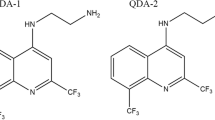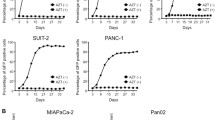Abstract
Treatment with fludarabine phosphate (9-β-D-arabinofuranosyl-2-F-adenine 5′-phosphate, F-araAMP) leads to regressions and cures of human tumor xenografts that express Escherichia coli purine nucleoside phosphorylase (EcPNP). This occurs despite the fact that fludarabine (F-araA) is a relatively poor substrate for EcPNP, and is cleaved to liberate 2-fluoroadenine at a rate only 0.3% that of the natural E. coli PNP substrate, adenosine. In this study, we investigated a panel of naturally occurring PNPs to identify more efficient enzymes that may be suitable for metabolizing F-araA as part of experimental cancer therapy. We show that Trichomonas vaginalis PNP (TvPNP) cleaves F-araA with a catalytic efficiency 25-fold greater than the prototypic E. coli enzyme. Cellular extracts from human glioma cells (D54) transduced with lentivirus stably expressing TvPNP (D54/TvPNP) were found to cleave F-araA at a rate similar to extracts from D54 cells expressing EcPNP, although much less enzyme was expressed per cell in the TvPNP transduced condition. As a test of safety and efficacy using TvPNP, human head and neck squamous cell carcinoma (FaDu) xenografts expressing TvPNP were studied in nude mice and shown to exhibit robust tumor regressions, albeit with partial weight loss that resolved post-therapy. F-araAMP was also a very effective treatment for mice bearing D54/TvPNP xenografts in which approximately 10% of tumor cells expressed the enzyme, indicating pronounced ability to kill non-transduced tumor cells (high bystander activity). Moreover, F-araAMP demonstrated activity against D54 tumors injected with an E1, E3 deleted adenoviral vector encoding TvPNP. In that setting, despite higher F-araA cleavage activity using TvPNP, tumor responses were similar to those obtained with EcPNP, indicating factors other than F-Ade production may limit regressions of the D54 murine xenograft model. Our results establish that TvPNP is a favorable enzyme for activating F-araA, and support further studies in combination with F-araAMP for difficult-to-treat human cancers.








Similar content being viewed by others
References
Parker WB, Sorscher EJ (2017) Use of E. coli purine nucleoside phosphorylase in the treatment of solid tumors. Curr Pharm Des 23:7003–7024
Hong JS, Waud WR, Levasseur DN, Townes TM, Wen H, McPherson SA, Moore BA, Bebok Z, Allan PW, Secrist JA III, Parker WB, Sorscher EJ (2004) Excellent in vivo bystander activity of fludarabine phosphate against human glioma xenografts that express the Escherichia coli purine nucleoside phosphorylase gene. Cancer Res. 64:6610–6615
Parker WB, Allan PW, Hassan AEA, Secrist JA III, Sorscher EJ, Waud WR (2003) Anti-tumor activity of 2-fluoro-2’-deoxyadenosine against tumors that express E. coli purine nucleoside phosphorylase. Cancer Gene Ther 10:23–29
Voeks D, Martiniello-Wilks R, Madden V, Smith K, Bennetts E, Both GW, Russell PJ (2002) Gene therapy for prostate cancer delivered by ovine adenovirus and mediated by purine nucleoside phosphorylase and fludarabine in mouse models. Gene Ther 9:759–768
Martiniello-Wilks R, Wang XY, Voeks DJ, Dane A, Shaw JM, Mortensen E, Both GW, Russell PJ (2004) Purine nucleoside phosphorylase and fludarabine phosphate gene-directed enzyme prodrug therapy suppresses primary tumour growth and pseudo-metastases in a mouse model of prostate cancer. J Gene Med. 6:1343–1357
Deharvengt S, Wack S, Aprahamian M, Hajri A (2005) Transcriptional tumor-selective promoter targeting of E. coli purine nucleoside phosphorylase for pancreatic cancer suicide gene therapy. J Gene Med. 7:672–680
Kikuchi E, Menendez S, Ozu C, Ohori M, Cordon-Cardo C, Logg CR, Kasahara N (2007) Bochner BH (2007) Delivery of replication-competent retrovirus expressing Escherichia coli purine nucleoside phosphorylase increases the metabolism of the prodrug, fludarabine phosphate and suppresses the growth of bladder tumor xenografts. Cancer Gene Ther. 14:279–286
Ungerechts G, Springfield C, Frenzke ME, Lampe J, Johnston P, Parker WB, Sorscher EJ, Cattaneo R (2007) Lymphoma chemovirotherapy: CD20-targeted and convertase-armed measles virus can synergize with fludarabine. Cancer Res. 67:10939–10947
Bossow S, Grossardt C, Temme A, Leber MF, Sawall S, Rieber EP, Cattaneo R, von Kalle C, Ungerechts G (2011) Armed and targeted measles virus for chemovirotherapy of pancreatic cancer. Cancer Gene Ther 18:598–608
Xie X, Guo J, Kong Y, Xie GX, Li L, Lv N, Xiao X, Tang J, Wang X, Liu P, Yang M, Xie Z, Wei W, Xie X (2011) Targeted expression of E. coli purine nucleoside phosphorylase and Fludara for prostate cancer therapy. J Gene Med. 13:680–691
Parker WB, Allan PW, Shaddix SC, Rose LM, Speegle HF, Gillespie GY, Bennett LL Jr (1998) Metabolism and metabolic actions of 6-methylpurine and 2-fluoroadenine in human cells. Biochem Pharmacol 55:1673–1681
Hughes BW, Wells AH, Bebok Z, Gadi VK, Garver RI Jr, Parker WB, Sorscher EJ (1995) Bystander killing of melanoma cells using the human tyrosinase promoter to express the Escherichia coli purine nucleoside phosphorylase gene. Cancer Res. 55:3339–3345
Hughes BW, King SA, Allan PW, Parker WB, Sorscher EJ (1998) Cell to cell contact is not required for bystander cell killing by E. coli purine nucleoside phosphorylase. J. Biol. Chem. 273:2322–2328
Parker WB, Allan PW, Waud WR, Hong JS, Sorscher EJ (2011) Effect of expression of adenine phosphoribosyltransferase on the in vivo anti-tumor activity of prodrugs activated by E. coli purine nucleoside phosphorylase. Cancer Gene Ther 18:390–398
Rosenthal EL, Chung TK, Parker WB, Allan PW, Clemons L, Lowman D, Hong J, Hung FR, Richman J, Conry RM, Mannion K, Carroll WR, Nabell L, Sorscher EJ (2015) Phase I dose-escalating trial of Escherichia coli purine nucleoside phosphorylase and fludarabine gene therapy for advanced solid tumors. Ann Oncol 26(7):1481–1487
Sorscher EJ, Hong JS, Allan PW, Waud WR, Parker WB (2012) In vivo antitumor activity of intratumoral fludarabine phosphate in refractory tumors expressing E. coli purine nucleoside phosphorylase. Cancer Chemother Pharmacol. 70:321–329
Scott RB, Brown GB (1962) The action of xanthine oxidase on some 2-substituted adenines. J Biol Chem 237:3215–3216
Parker WB, King SA, Allan PW, Bennett LL Jr, Secrist JA III, Montgomery JA, Gilbert KS, Waud WR, Wells AH, Gillespie GY, Sorscher EJ (1997) In vivo gene therapy of cancer with E. coli purine nucleoside phosphorylase. Hum Gene Ther 8:1637–1644
Becker TC, Noel RJ, Coats WS, Gomez-Foix AM, Alam T, Gerard RD, Newgard CB (1994) Use of recombinant adenovirus for metabolic engineering of mammalian cells. Methods Cell Biol 43:161–189
Wold WSM (1999) (eds) Adenovirus methods and protocols. Methods in molecular medicine, vol 21. Humana Press Totowa, New Jersey
Behbahani TE, Rosenthal EL, Parker WB, Sorscher EJ (2019) Intratumoral generation of 2-fluoroadenine to treat solid malignancies of the head and neck. Head Neck 41:1979–1983
Bharara B, Sorscher EJ, Gillespie GY, Lindsey JR, Hong JS, Curlee KV, Allan PW, Gadi VK, Alexander SA, Secrist JA III, Parker WB, Waud WR (2005) Antibiotic-mediated chemoprotection enhances adaptation of E. coli PNP for herpes simplex virus based glioma therapy. Hum Gene Ther 16:339–347
Secrist JA III, Parker WB, Allan PW, Bennett LL Jr, Waud WR, Truss JW, Fowler AT, Montgomery JA, Ealick SE, Wells AH, Gillespie GY, Gadi VK, Sorscher EJ (1999) Gene therapy of cancer: activation of nucleoside prodrugs with E. coli purine nucleoside phosphorylase. Nucleosides Nucleotides 18:745–757
Acknowledgments
We thank Jan Tindall for help with preparation and revision of the manuscript. The research reported in this publication was supported in part by the Cancer Animal Models shared resource of Winship Cancer Institute of Emory University and NIH/NCI under award number P30CA138292. The content is solely the responsibility of the authors and does not necessarily represent the official views of the National Institutes of Health.
Funding
The work was funded by NIH grant CA119170, R01DE026941, 5T32CA160040, and the Georgia Research Alliance.
Author information
Authors and Affiliations
Corresponding author
Ethics declarations
Conflict of interest
Dr. Parker and Dr. Sorscher have ownership interests in PNP Therapeutics and serve on the Board of Directors for the company, which develops products used in research described by the paper. Drs. Parker and Sorscher are also inventors of technology being evaluated in studies described by this report. The terms of this arrangement for Dr. Sorscher have been reviewed and approved by Emory University in accordance with its conflict of interest policies. Paula Allan and Jeong Hong also have minor equity interest in this company.
Additional information
Publisher's Note
Springer Nature remains neutral with regard to jurisdictional claims in published maps and institutional affiliations.
Rights and permissions
About this article
Cite this article
Parker, W.B., Allan, P.W., Waud, W.R. et al. The use of Trichomonas vaginalis purine nucleoside phosphorylase to activate fludarabine in the treatment of solid tumors. Cancer Chemother Pharmacol 85, 573–583 (2020). https://doi.org/10.1007/s00280-019-04018-7
Received:
Accepted:
Published:
Issue Date:
DOI: https://doi.org/10.1007/s00280-019-04018-7




